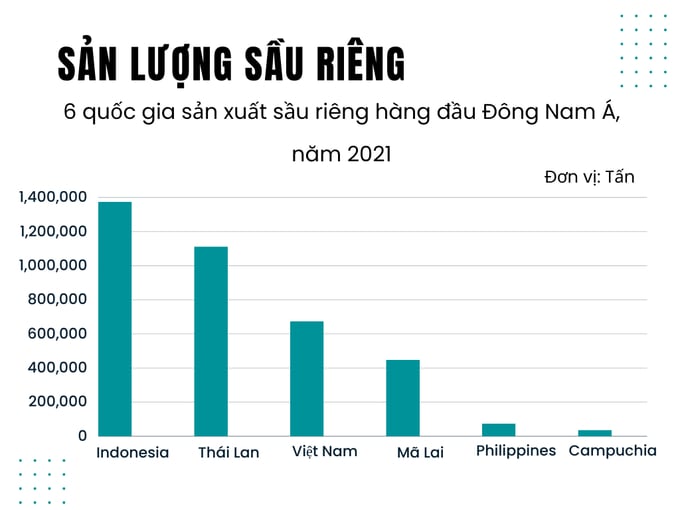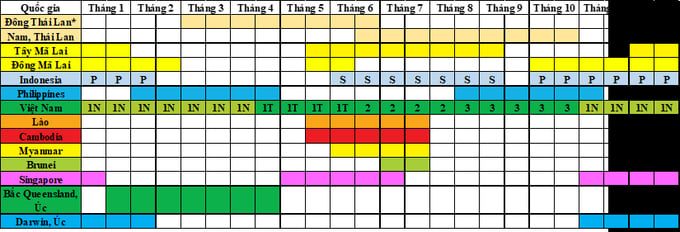June 15, 2025 | 15:27 GMT +7
June 15, 2025 | 15:27 GMT +7
Hotline: 0913.378.918
June 15, 2025 | 15:27 GMT +7
Hotline: 0913.378.918
Durian is a unique fruit tree with a high economic value that is grown in several Southeast Asian nations including Indonesia, Thailand, Malaysia, Vietnam, the Philippines, and Cambodia...

Durian is a product that brings high economic value to farmers. Photo: Kim Anh.
According to 2021 figures (Manakit Somboon, 2022), Indonesia is the world leader in durian production, with approximately 1.37 million tons, followed by Thailand (1.11 million tons). Vietnam comes in third place with 0.67 million tons, below Malaysia, the Philippines, and Cambodia. Although Indonesia produces a considerable amount of durian, it primarily serves internal consumption, with just a little proportion shipped to Singapore, Malaysia, and China, rendering Indonesian durian almost non-competitive with other regional countries.
Durian is farmed predominantly in Thailand's eastern provinces bordering Cambodia and southern provinces neighboring Malaysia. Chanthaburi is Thailand's top durian producer, accounting for more than half of total production. Due to the high revenues from durian farming in recent years, farmers in Thailand's northeastern region, bordering Cambodia, have also shifted to cultivating durian instead of rubber, cassava, and other crops.
Due to geographical variations, the climate of the eastern provinces is influenced by the Gulf of Thailand, whereas the climate of the southern provinces is influenced by the Indian Ocean. As a result, the flowering and harvesting seasons for durian differ between these two regions. Durian is harvested in the eastern provinces from March to June, and in the southern provinces from June to October.

According to 2021 statistics (Manakit Somboon, 2022), Indonesia has the world's leading durian production with over 1.37 million tons. Photo: Kim Anh.
Thai durian farmers frequently do not use the right flowering processes, hence there is little durian available for export outside of the seasonal window. Monthong is the most commonly farmed and exported durian variety in Thailand, followed by Chanee and Kanyao.
Thailand's durian production area has increased by an average of 8% per year in recent years. Thailand shipped durians to China for 4.9 billion USD in 2022, breaking a 30-year record and grabbing 96% of the Chinese market. Thailand exported durians worth approximately $4 billion USD in the first eight months of 2023. Despite being the biggest durian exporter, Thailand is concerned about competition in the next years from Vietnam and the Philippines. The Thai government's primary worry is the quality of exported durians because durian prices are high at the start of the season, and dealers frequently select durians before they are fully mature, resulting in lower quality and the reputation of Thai durians.
Durians are grown in two regions in Malaysia: the west and the east, resulting in varied seasonal patterns. Malaysia used to grow durians on a modest scale as part of a mixed farming practice. However, since 2011, durian has been identified as a new source of income for the Malaysian agriculture industry and has been included in agricultural development programs.
Since 2019, Malaysia has been permitted to export frozen durians to China, resulting in an increase in durian cultivation areas moving from oil palm fields. D24 was the most prevalent durian type in Malaysia until the previous 30 years when Musang King gained popularity and progressively supplanted D24.
Musang King durians are valued 4-5 times higher than Monthong durians in the Chinese market. Due to Malaysia's restricted durian production, exports to the Chinese market account for just approximately 4-5% of total output.
The Philippines got a letter of recommendation from China for the import of fresh durians in early 2023, making it the fourth country after Thailand, Malaysia, and Vietnam to export durians to China. This year, the Philippines hopes to sell at least 54,000 tons of premium durians to China. From October 25 to October 28, the Philippines sponsored the first Southeast Asian International Durian Conference in Davao City. Durians from the Philippines are harvested from February to April and from August to October each year, according to Dole, a major durian importer in China, which can compensate for the off-season in the Thai durian market.

The main Vietnamese durian varieties are Monthong and Ri6. Durian is harvested by cutting 1-2 times when the fruit is mature. Photo: Kim Anh.
Durians are mostly grown in the Cambodian provinces of Kampot, Kampong Cham, Koh Kong, and Battambong. Cambodia's soil and climate conditions are similar to those found in Vietnam and Thailand, making it an ideal location for durian growing.
According to Department of Growing (Ministry of Agriculture and Rural Development) forecasts, the durian growing area in Vietnam in 2023 will reach 131,000 hectares, a 20% increase from 2022, with a production of 1 million tons. Monthong and Ri6 durian cultivars are widely grown in Vietnam. Durians are collected by cutting them 1-2 times when they reach maturity and then processed for export ripening using processes similar to those used in Thailand.
The Mekong Delta, the southeastern area, and the Central Highlands are currently the three main production regions of Vietnam. The harvesting season begins in the Mekong Delta in April and continues through June, followed by the southeastern region in May and July, and the Central Highlands in August and October. However, because of water management advantages and the use of flowering induction techniques, the Mekong Delta can produce durians all year, giving Vietnam a competitive advantage when competing with other countries in the region.
Vietnam's durian exports reached just over 400 million USD in 2022, but 1.63 billion USD in the first nine months of 2023. According to the Fruit and Vegetable Association, durian export value could reach 2-2.5 billion USD in 2024.
Despite only being in the mainstream Chinese export market for a year, Vietnam's durian export value is 30% that of Thailand. Vietnam is particularly concerned about the development and competition of Vietnamese durians in the next five years due to a substantial durian agricultural area, similar soil and climate conditions, and shared types and harvesting techniques with Thailand.
Durian is a fruit tree with a high economic value that is seeing substantial expansion in all Southeast Asian countries, although the export market is mostly centered on China. As a result, each country must consider competition for survival and progress. Indonesia, Thailand, Vietnam, Malaysia, the Philippines, and Cambodia are Southeast Asia's top six durian producers. Through a letter of recommendation, China has suggested that fresh durians be exported to Thailand, Malaysia, Vietnam, and the Philippines.
Thailand is a direct and powerful competitor, and Cambodia is a potential competitor. This is due to the fact that both countries cultivate Monthong durian types and use identical harvesting and post-harvest processing processes as Vietnam.
Thailand has a huge land area and high output, and it has been exporting to the Chinese market for many years, with well-established infrastructure and a stable market, providing it a considerable edge over Vietnam, which has only recently begun exporting to this market.

Durian flowering and harvesting season in countries around the world. Photo: TVH.
Furthermore, the Thai government is aware of the growth of Vietnamese durians and has consistently enacted regulations to manage quality, construct infrastructure, create favorable conditions, and provide the best support possible for durian exports. Meanwhile, Cambodia enjoys similar terrain and climate conditions to Vietnam. In contrast to tiny, traditionally cultivated durian orchards, which can result in high output and quality, durians in Cambodia are increasingly frequently invested in on a huge scale with new techniques and superb infrastructure.
Cambodian durians are currently exported to China under the Thai brand. As a result, Vietnam's durian must capitalize on the harvest season in the Central Highlands, which has a higher production volume than southern Thai durians, as well as year-round production in the Mekong Delta when Thai durian supply is limited in January and February (Table 1).
Furthermore, ensuring the quality of the fruit by harvesting at the appropriate ripeness, avoiding chemical residue, and post-harvest processing to maintain the best quality for export to uphold the reputation of the growing region and national brand are critical issues that farmers, purchasing businesses, and local governments should focus on. Furthermore, in order to maintain sustainable durian use, the government should actively explore and develop consumer markets.
Translated by Linh Linh

(VAN) The working delegation from the Ministry of Agriculture and Environment conducted an important trip to the Netherlands to strengthen strategic partnerships and sustainable development in the agricultural sector.

(VAN) The letter ‘A Plea from the Ocean’ not only evokes emotion but also awakens the human conscience to the responsibility of protecting life on Earth.

(VAN) The Department of Agriculture in South Africa has announced the country’s first mass vaccination of poultry to prevent local birds from contracting avian influenza.

(VAN) Establishment of the Mekong Delta Regional Agricultural Linkage Center, aiming for a closed value chain, deep processing, trading platforms, and international market connectivity.

(VAN) Gia Lai province has recently recorded 460 rare species of animals and plants, contributing to forest conservation and biodiversity planning in the region.

(VAN) Ms. Caroline Beresford, New Zealand Ambassador to Vietnam, expressed confidence that agricultural cooperation between Vietnam and New Zealand will develop sustainably, be climate-resilient, and promote gender equality.

(VAN) Vietnam reaffirms its commitment to international cooperation in fostering sustainable and responsible fisheries while ensuring resilient livelihoods for small-scale fishing communities.